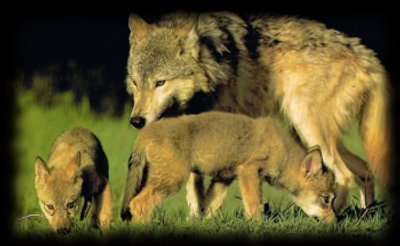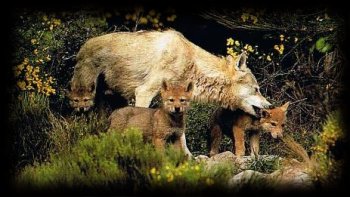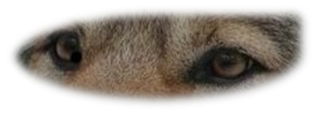Wolf
From the puppy to the grown wolf

It is like with human beings: He goes lonely by the region, in search of her, she also looks, as well lonely; they meet, they like each other, they marry and bring up their children - and if he has not become weak or too old, about five years this will go on this way - latter, luckily, only with the wolf.
However, it is not completely as well as with the people, because wolves only during the time of pairing head for the other gender. The meeting can be accidental or steered by the extreme senses of the wolf. The sence of smell plays the decisive role. But first the common howling points out both genders on each other. If the howling is answered, one goes up on each other. The distance can amount to several kilometers. Only if they are so close that they can pick up the scent and the hormone signals delivered about the body can be smelt, it becomes clear whether they are determined for each other or not.
The wolf pairs shows affection over the whole year, but during the snarl she it is particularly violent. The pair sleeps close together, it licks itself frequently and mutually the fur and walks together. Mutually the partners lie down the front paws on the shoulders of each other and let out no occasion to tender touches. Short before the copulation the pair withdraws itself, as long as it is an already existing herd, some days to avoid every disturbance by other herd members.
In the northern area the mating takes place between March and April, in the south earlier. The wolves usually are ready for mating when they are two years old. The physical connection is not so firm with the wolves as with the dogs. While dogs can come undone of each other only after ending of the mating act, it is possible with wolves at any time - for a precautionary measurement with threatening danger. However, the union can last up to 30 minutes.
If it is an already existing herd, only the alpha-animals pair off. All other animals whether male or female, are set under psycological stress by the leading wolves so that they do not dare to win over the favour of the other gender. One also supposes that it comes by the stress to an increased payment of adrenalin by which the conception and generation readiness of the animals is prevented.
All these behaviors limit the number of births and it remains the size of the herd in the balance and so with the food offer of its district.
For the birth and breeding of the puppies a cave is applied ideally. If this should not be possible, a building is dug or cliff or only a close wood with alders, meadows or whitethorn is sufficient.The throw boiler is in a cave at the end of an approximately ten meters lasting underground way which is dug by the female. It is a hard work to create an underground building with such sizes and one asks himself, why a pregnant animal takes these extreme efforts on itself, even if other dwellings were possible for the first life weeks of the descendants.

The reason is that wolves are very careful. The female digs so deeply into the earth, since outwardly no sounds penetrate. So the sounds of the puppies will not penetrate later also up to caves entrance and the first completely helpless descendants are sure. Besides, the throw boiler lies something about the level of the caves entrance not to be flooded by rainwater. Living caves are used by many generations and gives the efforts which the she-wolf takes on itself, absolutely a sense. In Canada one discovered a cave whose surroundings were dotted with bone of preys. By an age-test of the bones one found out that this cave was already used since 800 years as a living cave.
The small wolves are born after a pregnancy of 61 to 63 days. To the north of the 45th latitude the puppies are born between end of April and at the middle of May. Southerly of it they are born between middle of March and April. A throw has as a rule five to seven puppies which are blind and deaf and weigh only approximately 500 grammes. The newborn child resemble with their short snout, the short legs, thin little tails and small ears to be rather a bear's baby than a wolf's.
The young puppies first are completely helpless. However, their sense of smell is coined already very well. Why the small wolves are born so underdeveloped, always gave to speculations. Ronald Lawrence, wild biologist from the USA, believes that by switching off all other senses and the concentration exclusively on the sense of smell the puppy receive a deeper stamp on their family-specific smell and with it a firmer connection appears.
The she-wolf has eight teats, four on every side of the stomach. If the throw is bigger than eight puppies, some of the puppies die mostly because of malnutrition. The she-wolf carries the dead child from the building and digs it in a deep hole. The dead puppies are not eaten by other wolves of the herd.
The puppies most probably recognize their mother by the vibration of the earth, because only with approximately 14 days the puppies begin to hear and can react suddenly to loud sounds. At the same time they open their eyes which are in the first weeks blue.
If the puppies are 20 days old, they do a development thrust which takes out them within few days from their baby's existence. The legs become longer and longer, the ears, which hang down until now, place themselves, and the small snout stretches itself to the wolf snout. With it up and down there goes the development of their behavior and the typical wolf qualities. In the fourth life week 60% all behaviors available to a wolf develop themselves; after another one to two weeks they have already reached 80%. There are only no behaviors which have to do with sexuality and puppy's breeding.
From the moment in where meat is offered to the small wolves of the mother, the jealousy about food also begins. With growling and attacks the fodder is also defended opposite the brothers and sisters. The mother is usually the exclusive attachment figure for the puppies. If she goes, however, with other herd members on the hunt, an aunt or another female from the herd steps in as a babysitter. Wolf baby-sitters are even able to produce milk when required and can take over either temporarily or completely the mother's role if the mother dies. The feminine wolves are besotted with the small wolves and tear themselves over the role of the baby-sitter. Also the males are procured very much. A dog was observed even with the fact that after the death of the mother he tried to nurse the puppies.
Eight weeks after the birth the puppies weigh approximately 7 kg and are not dependent any more on nursing than source of food. The males are around 20% heavier than the females. Now the milk set of teeth is fully developed. Then with five or six months the duration teeth break.
With approximately eight weeks the puppies leave the building. One names the place in which the puppies are brought now "puppy's hoard" or "wolf warehouse". This was selected by the alpha-animals very carefully. It is a place close to water in more or less open ground which is surrounded with trees and by bushes. In the bushes the puppies can coach undisturbed their later abilities, can go independently on mouse's hunt. However, it is taught them also discipline. A stubborn wolf is packed in the neck fur by the mother or the nurse and is shaken. A unique shaking is usually sufficient to teach the correct behaviour to the puppy.
With approximately 3 months the offspring may accompany the herd on the hunt. Even thouth the young animals are only taken under marking and as a tail light, the decisive steps are, nevertheless, for learning the hunting behavior in the herd. Then after other 3 months the puppies participate actively in the hunt.
Still for the time of the babybeeing the new family or extended family is connected out intimately with each other and up to sexual maturity of the puppies the life is accompanied in the herd by tenderness and loving games. Only if the puppies become ripe for gender, the connections come undone. However, the ruban between the parents continues mostly about many years, sometimes even a life long.
© Alaskan-Malamute.ch


